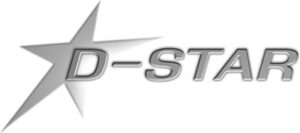
Simplex QSO
D-STAR is not only used to have QSOs through a reflector but can also easily be used for a one-on-one QSO. The only thing you have to take care of is that both parties have a D-STAR compatible radio, that you use the same frequency (i.e. no or 0 kHz shift) and that you both set the mode to DV. After this, it is nothing more than pressing the PTT to start the QSO.
Setting to connect to reflector
To use a reflector, a few parameters must be set correctly, but first make sure the radio is set to DR mode.
MYCALL or MY This is where you set your call sign
URCALL or UR Here you set the command you want to send to the repeater. For a QSO over the repeater you enter CQCQCQ.
RPT2 or R2 Here you set the call sign of the repeater you want to connect to. On the rightmost position in this parameter you enter the capital G (as in Gateway).
RPT1 or R1 This parameter indicates to which module in the repeater your signal should be routed. This parameter usually starts with the call sign of the repeater (the same as in RPT2) and on the rightmost position the capital letters A, B or C. The chosen letter determines to which module, and thus band, your signal will be routed.
- A : 23cm band
- B : 70cm band
- C : 2m band
The parameter fields are 8 characters wide, this means the A,B,C or G in the RPT1 and RPT2 parameters needs to be filled with space characters between the call sign and A,B,C,G character. A useful tool to determine these parameters is the online D-STAR web calculator.
Settings I might use to connect to a local D-STAR repeater:UR: CQCQCQ
R2: PI1MEP֊G
R1: PI1MEP֊B
In this example ֊ represents a space character in the settings on the radio.
Reflector commands
It is possible to send commands to a repeater or reflector from the radio. These commands must be entered in the UR or URCALL parameter of the radio. The table below list a set of useful commands.
| Function | Command example in UR parameter | Remark |
|---|---|---|
| Normal operation, i.e. performing a QSO | CQCQCQ | |
| Request link status information from repeater or reflector | ֊֊֊֊֊֊LI | 6 spaces before LI |
| Link to a REF reflector, e.g. REF017 B | REF017BL | |
| Link to a DCS reflector, e.g. DCS007 B | DCS007BL | |
| Link to a XRF reflector, e.g. XRF088 B | XRF088BL | |
| Link to a XLX reflector, e.g. XLX007 B | XLX007BL | |
| Unlink from one of the reflectors from above | ֊֊֊֊֊֊֊U | 7 spaces before U |
| Link to a CCS ID | C1234567 | CCS ID is the same as used for DMR |
| Unlink from CCS | CA֊֊֊֊֊֊ |
Modules
When selecting a reflector a single trailing letter is mandatory. This letter states which module is used in the reflector of choice. This modules are used to separate various talk groups within one reflector. There are no fixed meanings per letter, the manager of a reflector is free to determine this, but the following meanings per letter are applied to most reflectors:
- A : International oriented talk group
- B : National oriented talk group
- C: Regional oriented talk group
Letters higher up in the alphabet can be used to designate, for example, cities, provinces or districts. Their use depends very much on the use of the respective reflector and can therefore differ from one reflector to another.